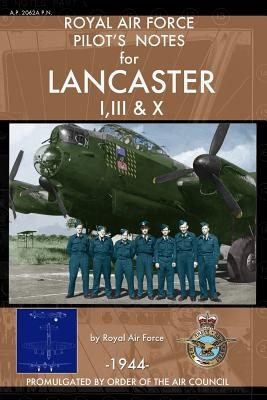
- We will send in 10–14 business days.
- Author: Royal Air Force
- Publisher: Periscope Film LLC
- ISBN-10: 1937684520
- ISBN-13: 9781937684525
- Format: 15.2 x 22.9 x 0.3 cm, minkšti viršeliai
- Language: English
- SAVE -10% with code: EXTRA
Royal Air Force Pilot's Notes for Lancaster I, III & X (e-book) (used book) | bookbook.eu
Reviews
Description
Designed by Avro's Roy Chadwick to replace the Manchester, the Lancaster four-engine bomber became the RAF's main heavy bomber during WWII. The most successful night bomber of WWII, it flew over 150,000 sorties over occupied Europe and delivered over 600,000 long tons of bombs. The "Lanc's" large bomb bay meant that it could carry the largest bombs in RAF inventory including the 12,000 lb "blockbuster" type called the "Tallboy", the "Grand Slam" 22,000 lb bomb, and (after receiving modifications) the "bouncing bombs" for the attack on Germany's Ruhr dams in 1943. The Lancaster carried a crew of seven: pilot, flight engineer, bombardier, radio operator, navigator and two gunners. The all-metal aircraft carried eight machine guns, and had a range of 3,000 miles, a ceiling of 23,500 feet, and a maximum speed of 280 mph.Over 7,300 Lancasters were built from 1941 through 1946. Of this number, 3,249 were lost in action. In addition to service with the R.A.F., Lancs flew for the Canadian and Australian air forces, in the Soviet Union, and after WWII for a variety of air forces worldwide. These pilot's notes were standard issue for R.A.F. pilots and flight engineers circa 1944. They contain information about aircraft operation, controls, handling, and emergencies.
- Author: Royal Air Force
- Publisher: Periscope Film LLC
- ISBN-10: 1937684520
- ISBN-13: 9781937684525
- Format: 15.2 x 22.9 x 0.3 cm, minkšti viršeliai
- Language: English English
Designed by Avro's Roy Chadwick to replace the Manchester, the Lancaster four-engine bomber became the RAF's main heavy bomber during WWII. The most successful night bomber of WWII, it flew over 150,000 sorties over occupied Europe and delivered over 600,000 long tons of bombs. The "Lanc's" large bomb bay meant that it could carry the largest bombs in RAF inventory including the 12,000 lb "blockbuster" type called the "Tallboy", the "Grand Slam" 22,000 lb bomb, and (after receiving modifications) the "bouncing bombs" for the attack on Germany's Ruhr dams in 1943. The Lancaster carried a crew of seven: pilot, flight engineer, bombardier, radio operator, navigator and two gunners. The all-metal aircraft carried eight machine guns, and had a range of 3,000 miles, a ceiling of 23,500 feet, and a maximum speed of 280 mph.Over 7,300 Lancasters were built from 1941 through 1946. Of this number, 3,249 were lost in action. In addition to service with the R.A.F., Lancs flew for the Canadian and Australian air forces, in the Soviet Union, and after WWII for a variety of air forces worldwide. These pilot's notes were standard issue for R.A.F. pilots and flight engineers circa 1944. They contain information about aircraft operation, controls, handling, and emergencies.


Reviews